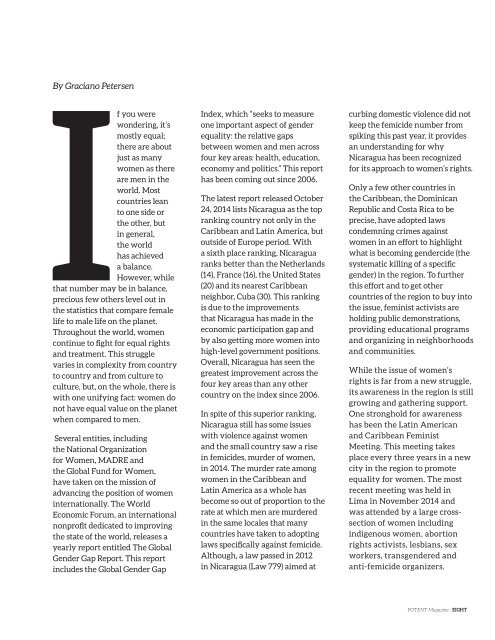POTENT Issue #2 - The Women's Issue
You also want an ePaper? Increase the reach of your titles
YUMPU automatically turns print PDFs into web optimized ePapers that Google loves.
By Graciano Petersen<br />
If you were<br />
wondering, it’s<br />
mostly equal;<br />
there are about<br />
just as many<br />
women as there<br />
are men in the<br />
world. Most<br />
countries lean<br />
to one side or<br />
the other, but<br />
in general,<br />
the world<br />
has achieved<br />
a balance.<br />
However, while<br />
that number may be in balance,<br />
precious few others level out in<br />
the statistics that compare female<br />
life to male life on the planet.<br />
Throughout the world, women<br />
continue to fight for equal rights<br />
and treatment. This struggle<br />
varies in complexity from country<br />
to country and from culture to<br />
culture, but, on the whole, there is<br />
with one unifying fact: women do<br />
not have equal value on the planet<br />
when compared to men.<br />
Several entities, including<br />
the National Organization<br />
for Women, MADRE and<br />
the Global Fund for Women,<br />
have taken on the mission of<br />
advancing the position of women<br />
internationally. <strong>The</strong> World<br />
Economic Forum, an international<br />
nonprofit dedicated to improving<br />
the state of the world, releases a<br />
yearly report entitled <strong>The</strong> Global<br />
Gender Gap Report. This report<br />
includes the Global Gender Gap<br />
Index, which “seeks to measure<br />
one important aspect of gender<br />
equality: the relative gaps<br />
between women and men across<br />
four key areas: health, education,<br />
economy and politics.” This report<br />
has been coming out since 2006.<br />
<strong>The</strong> latest report released October<br />
24, 2014 lists Nicaragua as the top<br />
ranking country not only in the<br />
Caribbean and Latin America, but<br />
outside of Europe period. With<br />
a sixth place ranking, Nicaragua<br />
ranks better than the Netherlands<br />
(14), France (16), the United States<br />
(20) and its nearest Caribbean<br />
neighbor, Cuba (30). This ranking<br />
is due to the improvements<br />
that Nicaragua has made in the<br />
economic participation gap and<br />
by also getting more women into<br />
high-level government positions.<br />
Overall, Nicaragua has seen the<br />
greatest improvement across the<br />
four key areas than any other<br />
country on the index since 2006.<br />
In spite of this superior ranking,<br />
Nicaragua still has some issues<br />
with violence against women<br />
and the small country saw a rise<br />
in femicides, murder of women,<br />
in 2014. <strong>The</strong> murder rate among<br />
women in the Caribbean and<br />
Latin America as a whole has<br />
become so out of proportion to the<br />
rate at which men are murdered<br />
in the same locales that many<br />
countries have taken to adopting<br />
laws specifically against femicide.<br />
Although, a law passed in 2012<br />
in Nicaragua (Law 779) aimed at<br />
curbing domestic violence did not<br />
keep the femicide number from<br />
spiking this past year, it provides<br />
an understanding for why<br />
Nicaragua has been recognized<br />
for its approach to women’s rights.<br />
Only a few other countries in<br />
the Caribbean, the Dominican<br />
Republic and Costa Rica to be<br />
precise, have adopted laws<br />
condemning crimes against<br />
women in an effort to highlight<br />
what is becoming gendercide (the<br />
systematic killing of a specific<br />
gender) in the region. To further<br />
this effort and to get other<br />
countries of the region to buy into<br />
the issue, feminist activists are<br />
holding public demonstrations,<br />
providing educational programs<br />
and organizing in neighborhoods<br />
and communities.<br />
While the issue of women’s<br />
rights is far from a new struggle,<br />
its awareness in the region is still<br />
growing and gathering support.<br />
One stronghold for awareness<br />
has been the Latin American<br />
and Caribbean Feminist<br />
Meeting. This meeting takes<br />
place every three years in a new<br />
city in the region to promote<br />
equality for women. <strong>The</strong> most<br />
recent meeting was held in<br />
Lima in November 2014 and<br />
was attended by a large crosssection<br />
of women including<br />
indigenous women, abortion<br />
rights activists, lesbians, sex<br />
workers, transgendered and<br />
anti-femicide organizers.<br />
<strong>POTENT</strong> Magazine | EIGHT



